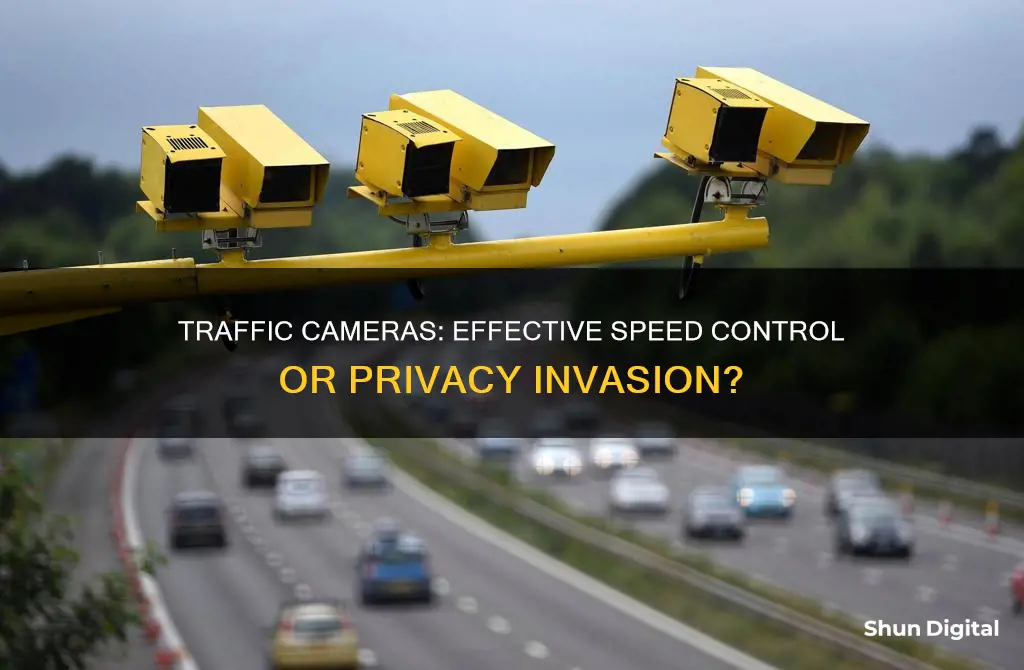
Traffic cameras are an increasingly common feature of roads worldwide. They are used to detect motoring offences, including speeding, red-light running, and unauthorised use of bus lanes. The use of traffic cameras to reduce speeding is controversial. Some argue that they are an effective way to get drivers to slow down and reduce road traffic injuries and deaths. For example, a review of studies found that speed cameras led to an 11% to 44% reduction in fatal and serious injury crashes. On the other hand, critics argue that they are a financial burden on those least able to pay and a way for local governments to raise revenue.
| Characteristics | Values |
|---|---|
| Speed cameras reduce the number of collisions | Yes |
| Speed cameras reduce the number of injuries | Yes |
| Speed cameras reduce the number of vehicles involved in collisions | Yes |
| Speed cameras reduce the number of road traffic crashes | Yes |
| Speed cameras reduce the number of road traffic injuries and deaths | Yes |
| Speed cameras reduce the number of fatal and serious injury crashes | Yes |
| Speed cameras reduce the number of personal injury collisions | Yes |
| Speed cameras reduce the number of people killed or seriously injured at camera sites | Yes |
What You'll Learn
- Speed cameras are effective in reducing the number of road collisions and injuries
- Speed cameras are a worthwhile intervention for reducing the number of road traffic injuries and deaths
- Speed cameras are effective at reducing accidents and injuries in their vicinity
- Speed cameras are a neutral alternative to police stops, which can be potentially biased by race
- Speed cameras are effective in changing drivers' behaviour

Speed cameras are effective in reducing the number of road collisions and injuries
Speed cameras are an effective tool in reducing the number of road collisions and injuries. Studies have shown that speed cameras reduce the number of crashes and injuries, with some studies reporting reductions of up to 50% in crashes and 44% in fatal and serious injury crashes. The presence of speed cameras encourages drivers to adhere to speed limits, which reduces the likelihood and severity of crashes.
The effectiveness of speed cameras in reducing collisions and injuries has been demonstrated in various settings, including urban areas and highways. For example, a study in Barcelona, Spain, found that speed cameras installed on the city's beltway reduced the relative risk of a road collision by 27%. Similarly, a review of 35 studies on speed cameras showed a reduction in average speeds and a decrease in the number of crashes, with most studies reporting reductions in the 11% to 27% range.
The use of speed cameras is particularly important in areas with high traffic volumes and vulnerable road users, such as pedestrians and cyclists. By enforcing speed limits, speed cameras create a safer environment for all road users and help prevent serious injuries and fatalities.
While some critics argue that speed cameras are primarily a revenue source for local governments, the positive impact on road safety cannot be overlooked. The consistency of reported reductions in speed and crash outcomes across studies reinforces the effectiveness of speed cameras in reducing road traffic injuries and deaths.
To further enhance the benefits of speed cameras, it is essential to complement their use with well-designed road infrastructure. This includes implementing road diets, narrowing lanes, and adding physical barriers to reduce speeding and protect vulnerable road users. Additionally, addressing loss of privacy and mass surveillance concerns associated with automatic number-plate recognition systems is crucial for maintaining public trust in the use of speed cameras.
The Evolution of the First Multiplane Camera
You may want to see also

Speed cameras are a worthwhile intervention for reducing the number of road traffic injuries and deaths
Speed cameras are an effective tool in reducing the number of road traffic injuries and deaths. A review of 35 studies found that all studies reported a reduction in average speeds after the introduction of speed cameras. The reduction in the proportion of speeding vehicles ranged from 8% to 70%, with most countries reporting reductions in the 10% to 35% range.
The review also found that 28 studies reported a lower number of crashes in speed camera areas after their implementation. In the vicinity of camera sites, the reductions ranged from 8% to 49% for all crashes, with most studies reporting reductions in the 14% to 25% range. For injury crashes, the decrease ranged from 8% to 50%, while for crashes resulting in fatalities or serious injuries, the reductions were in the range of 11% to 44%.
The effectiveness of speed cameras in reducing crashes and injuries is further supported by a study conducted in Barcelona, Spain. The study found that after two years of speed camera operation on the city's beltway, there was a significant decrease in the number of road traffic collisions, not only on the beltway but also on arterial roads without speed cameras. The relative risk of a road collision occurring on the beltway after the installation of speed cameras was 0.73, indicating a protective effect.
While some critics argue that speed cameras are a financial burden on those least able to pay, safety advocates counter that they are a necessary tool to address the rising number of traffic fatalities and injuries. By reducing speeding, which is a significant contributor to crashes, speed cameras can help save lives and prevent serious injuries.
To ensure the effective use of speed cameras, several factors should be considered. One crucial aspect is the placement of cameras in areas with high speeding rates and a history of crashes. Additionally, combining speed cameras with other interventions, such as road redesign and speed feedback signs, can further enhance their impact.
In conclusion, speed cameras have been proven to be a worthwhile intervention for reducing road traffic injuries and deaths. They play a vital role in enforcing speed limits, changing driver behaviour, and ultimately saving lives. However, it is essential to continuously evaluate their effectiveness and address any concerns related to their implementation and impact on different communities.
Finding the Mode Button on the Hero 5 Camera
You may want to see also

Speed cameras are effective at reducing accidents and injuries in their vicinity
Speed cameras are an effective tool to reduce accidents and injuries on the road. They are one of the many tools used to enforce lower speeds and reduce the number of road collisions.
A study in Barcelona, Spain, found that speed cameras installed on the beltway of the city were effective in reducing the number of road collisions and, consequently, the number of injured people and vehicles involved in collisions. The relative risk of a road collision occurring on the beltway after the installation of speed cameras was 0.73, indicating a protective effect. The study also showed that the protective effect of speed cameras was greater during weekend periods.
Another study in Phoenix, Arizona, examined the effects of speed cameras on a 26-mile segment of interstate I-10. The results showed that the placement or removal of speed cameras did not independently affect the incidence of motor vehicle collisions. However, it is important to note that this study did not specifically address injuries or fatalities resulting from collisions.
A review of 35 studies on the effectiveness of speed cameras found that all studies reporting speed outcomes reported a reduction in average speeds after the introduction of speed cameras. The reduction in the proportion of speeding vehicles ranged from 8% to 70%, with most countries reporting reductions in the 10% to 35% range.
The UK Department for Transport estimated that speed cameras led to a 22% reduction in personal injury collisions and 42% fewer people being killed or seriously injured at camera sites. An LSE study in 2017 supported this, finding that adding another 1,000 cameras to British roads could save up to 190 lives annually, reduce up to 1,130 collisions, and mitigate 330 serious injuries.
The British Medical Journal reported in 2003 and 2005 that speed cameras were effective at reducing accidents and injuries and recommended wider deployment. However, most studies did not have satisfactory control groups, which could impact the reliability of the results.
While speed cameras have been shown to be effective in reducing accidents and injuries, there are also concerns about their use. Some critics argue that speed cameras are a financial burden on those who are least able to pay, and there are concerns about privacy and the potential for mass surveillance by governments. Additionally, some groups claim that the use of speed traps as a revenue source undermines the legitimacy of safety efforts.
The Kodak 35 Camera: A Historical Perspective
You may want to see also

Speed cameras are a neutral alternative to police stops, which can be potentially biased by race
Speed cameras are an effective way to reduce speeding and road collisions. They are a neutral alternative to police stops, which can be potentially biased by race. While some may argue that speed cameras are an invasion of privacy or a way for the government to generate revenue, these objections are often based on misconceptions and a lack of understanding of how speed cameras work and their intended purpose.
One of the main advantages of speed cameras is their ability to enforce speed limits in vulnerable areas such as school or construction zones. For example, a speed camera in a school zone can be programmed to enforce speeding during specific times of the day when children are walking to and from school. This targeted approach helps improve safety in areas where the risk of accidents and fatalities is higher.
Speed cameras also reduce the need for police traffic stops, which can be dangerous for both drivers and police officers. By automating speed enforcement, speed cameras free up police resources and reduce the potential for biased policing. In addition, speed cameras are nondiscriminatory and do not rely on the discretion of individual officers, addressing concerns of racial bias in policing.
Furthermore, speed cameras have been proven to change driver behaviour and increase compliance with speed limits. Studies have shown that the presence of speed cameras leads to a significant decrease in road traffic collisions and injuries. For instance, a study in Barcelona found that the relative risk of a road collision occurring after the installation of speed cameras was reduced by 27%. Similarly, a study in New York reported a 72% drop in speeding at fixed camera locations.
While there are varying results from different studies, the overall trend suggests that speed cameras are effective in reducing speeding and collisions. Speed cameras provide a neutral and consistent approach to speed enforcement, addressing concerns of bias and racial profiling in policing. By enforcing speed limits without discrimination, speed cameras improve road safety and save lives.
The Power of Camera Focus in UE4: Why Isn't it Default?
You may want to see also

Speed cameras are effective in changing drivers' behaviour
Speed cameras are an effective tool in changing driver behaviour and reducing speeding. A review of 35 studies found that speed cameras led to a reduction in speeding, with the proportion of vehicles exceeding the speed limit decreasing by between 8% and 70%. The review also found that the number of crashes decreased by between 8% and 49% in the vicinity of camera sites, with most studies reporting reductions in the 14% to 25% range.
The effectiveness of speed cameras in reducing speeding and crashes is supported by other sources. For example, a study in Barcelona found that the relative risk of a road collision occurring after the installation of speed cameras was 0.73, indicating a protective effect. Similarly, a study in Phoenix, Arizona, found that speed cameras did not increase or decrease the number of motor vehicle collisions, but the authors noted that they controlled for five confounding variables, which is unusual in such studies.
The British Medical Journal has also reported that speed cameras are effective at reducing accidents and injuries, and recommended their wider deployment. Additionally, a study in the UK found that average speed cameras significantly reduced speeding on the A9 and A96 roads.
While there are some concerns about the use of speed cameras, such as their potential use as a revenue source rather than a safety measure, the evidence suggests that they are an effective tool in changing driver behaviour and reducing speeding.
Understanding Camera's AHD Mode: What, Why, and How?
You may want to see also
Frequently asked questions
Yes, traffic cameras are effective in reducing speeding. A review of 35 studies found that all studies reporting speed outcomes reported a reduction in average speeds post-intervention with speed cameras. The reduction in the proportion of speeding vehicles ranged from 8% to 70%.
Traffic cameras are one of the tools used to enforce lower speeds and reduce road injuries and deaths. By reducing speeding, traffic cameras can also make roads safer for pedestrians and cyclists.
Traffic cameras are used worldwide, including in the US, UK, Canada, Australia, and Europe. They are typically mounted beside or over a road or installed in an enforcement vehicle.







